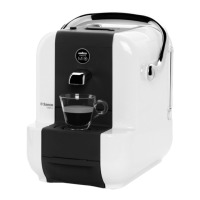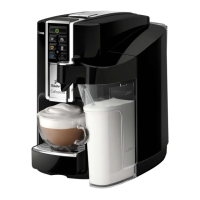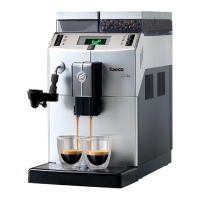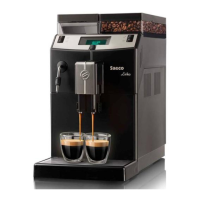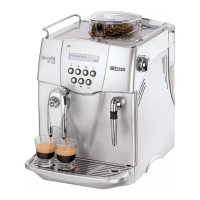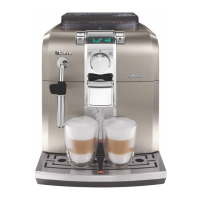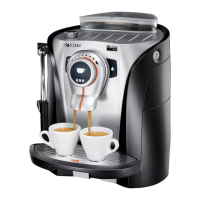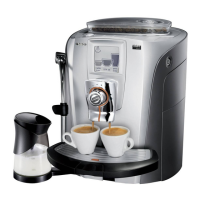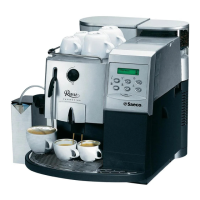What does Error 21 mean on my Saeco Coffee Maker?
- MmichelewalkerAug 15, 2025
Error 21 on your Saeco Coffee Maker indicates that the steam boiler is overheated.

What does Error 21 mean on my Saeco Coffee Maker?
Error 21 on your Saeco Coffee Maker indicates that the steam boiler is overheated.
What does Error 6 mean on a Saeco Coffee Maker?
Error 6 on your Saeco Coffee Maker indicates that one or more solenoid valves are in short-circuit and therefore cannot be used.
What does Error 10 mean on my Saeco Lavazza Omnia 120V Coffee Maker?
Error 10 on your Saeco Coffee Maker indicates that the coffee boiler NTC temperature sensor is in short-circuit.
What does Error 13 mean on a Saeco Lavazza Omnia 120V Coffee Maker?
Error 13 on your Saeco Coffee Maker means that the steam boiler NTC temperature sensor is in short-circuit.
What does error 14 mean on Saeco Lavazza Omnia 120V?
Error 14 on your Saeco Coffee Maker indicates that the coffee boiler supply is not connected.
What does error 15 mean on Saeco Lavazza Omnia 120V Coffee Maker?
Error 15 on your Saeco Coffee Maker indicates that the steam boiler supply is not connected.
What does Error 11 mean on a Saeco Lavazza Omnia 120V Coffee Maker?
Error 11 on your Saeco Coffee Maker indicates that the coffee boiler NTC temperature sensor is not connected.
What does Error 12 mean on my Saeco Coffee Maker?
Error 12 on your Saeco Coffee Maker means that the steam boiler NTC temperature sensor is not connected.
What does error 3 mean on Saeco Lavazza Omnia 120V Coffee Maker?
Error 3 on your Saeco Coffee Maker indicates that the brew unit could not be set to the Work position for capsule closing.
What does error 4 mean on Saeco Lavazza Omnia 120V?
Error 4 on your Saeco Coffee Maker indicates that the brew unit could not be released from the Work position.
| Voltage | 120V |
|---|---|
| Product Type | Coffee Maker |
| Bean Hopper Capacity | 300g |
| Pump Pressure | 15 bar |
| Color | Black |
Specifies the authorized usage scenarios for the appliance.
Provides fundamental safety guidelines for operating the machine.
Details precautions related to the machine's power cord.
Outlines measures to ensure user safety, especially concerning children.
Warns about potential burns from hot parts of the machine.
Introduces the purpose and importance of the manual.
Provides specific guidance and requirements for maintenance personnel.
Details the machine's features and its intended purpose and applications.
Acknowledges standards followed in design and certification stages.
Outlines mandatory actions and forbidden operations for safety.
Specifies procedures for safely unloading and handling the appliance.
Details the conditions and methods for storing the machine.
Lists critical precautions to observe before and during appliance installation.
Explains the function and location of the power button.
Describes the messages shown on the display during operation.
Outlines the function of the control buttons and their behavior.
Details the specific functions of each button during standard machine operation.
Provides step-by-step instructions for filling the machine's water tank.
Guides the initial setup and priming procedure before the first use.
Explains the function of buttons used for navigating programming menus.
Guides the user through customizing machine settings and parameters.
Details the procedure to access the machine's maintenance menu.
Guides on how to access the advanced technical programming features.
Describes the initial warm-up and cleaning cycle upon machine start.
Explains the cycle for rinsing coffee and milk circuits with fresh water.
Offers general advice and precautions for maintaining the machine.
Outlines a schedule for regular cleaning and maintenance tasks.
Details the process for cleaning the drip tray and capsule drawer.
Provides instructions for cleaning the capsule loading tray.
Lists machine warning messages and how to reset them.
Outlines steps for moving the machine to a different location.
Details procedures for storing the machine during long periods of inactivity.

